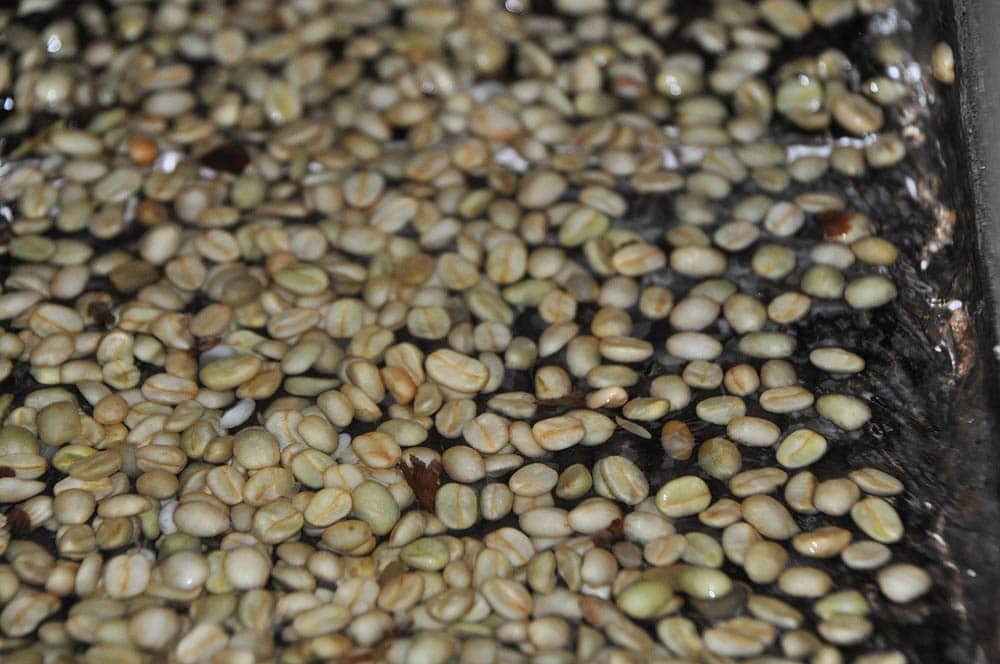
It is easy to overlook some of the steps between the coffee cherry growing on the branch and the delicious cup of coffee sitting in your favorite mug. Sure, most coffee drinkers are vaguely aware that coffee beans are seeds of a cherry tree, and, yes, they understand that there is some harvesting, processing, and roasting required to get the beans into the bags they buy. Still, most don’t realize how integral the processing step is to the final taste of their morning coffee.
In this article, we will discuss the most common method for processing coffee: washed processing. Virtually all specialty coffee beans are washed, and we’ll dive into the reasons, alternatives, and why you should care. Far from being an unimportant detail for others to worry about, how coffee beans are processed dramatically affects their flavor. Let’s find out why.

Coffee Processing in General
Before we discuss washed processing, we need to explain why coffee needs to be processed in the first place. Coffee beans are the seeds of coffee cherries, and coffee cherries are a lot like onions in that they’re layered. From the outside in, the layers of a coffee cherry are the skin, the mucilage, the endocarp or parchment, and the silverskin. The silverskin is the last layer between the seeds, or beans, and the rest of the fruit.
Before coffee beans can be shipped and roasted, all the layers must be removed, from the skin down to the silverskin, and the coffee beans have to be dried. Historically, coffee beans were processed naturally by allowing the fruit to shrivel before removing the soft layers surrounding the bean. The advantage of natural processing is it’s less labor-intensive and easier overall, making it easier for overworked farmers to produce more coffee.
Natural processing changes the coffee bean’s flavor by allowing the bean to absorb sugars from the fruit as it ferments during the drying process. The result is a sweet coffee bean with its flavor entirely determined by the fermentation and drying process. Any intrinsic flavors are lost, and the hard work of the coffee farmer is mostly in vain. The solution to this problem is washed processing.

Washed Coffee Processing
Unlike natural processing, washed processing removes all the layers except for the parchment and silverskin. The coffee beans then undergo fermentation in a controlled environment courtesy of a specialized, turbulent water pool designed specifically for processing coffee. Washed coffee is much more consistent than natural processed coffee and also a better representation of the coffee’s natural flavor.
Coffee aficionados gravitate towards washed coffee because it allows them to appreciate the difference between origins, growing conditions, and farming techniques that would be undetectable in naturally processed coffee. Coffee farming is a subtle art form, and the impact of secondary factors like soil composition and growing altitude is much smaller than the impact of choosing to process coffee naturally.
A helpful analogy is to consider dropping a pebble in a body of water. In a smooth, pristine lake, you’ll easily notice the splash and be able to watch the ripples spread across the surface. If you drop the same pebble in rolling six-foot seas, you’re not going to be able to see any effect. In this analogy, the pristine lake is washed processing, and the tumultuous sea is natural processing.
Washed processing is somewhat of a double-edged sword in that it shines a bright light on your coffee’s quality. A low-quality coffee bean can’t hide behind the sweetness of natural processing. Conversely, washed processing will let a bean’s natural strengths take center stage if you have a superb crop.
How Washed Processing Works
There are several steps to washed processing. The first step is separating damaged or overripe coffee cherries from healthy ones. To accomplish this task without painstakingly filtering the cherries by hand, coffee farmers devised an ingenious method using a pool of water. Defective cherries tend to be less dense than healthy cherries, meaning they will float to the top of the pool while the good cherries sink. This makes it trivially easy to remove the bad cherries without examining each one individually.
Next, a machine removes the skin, mucilage from the cherries, leaving the parchment and silverskin intact. This is the expensive step and what makes washed processing prohibitive for smaller, less affluent coffee farmers.
Since most of the fruit has already been removed from the seed, natural fermentation won’t occur during the drying process. To remedy this, coffee beans are fermented in water tanks for about 24 hours.
After fermentation is complete, the beans are dried. Large coffee farms use specialized drying equipment, but smaller farms tend to do it the old-fashioned way and use the sun. Sun drying comes with the additional risk of exposure to bacteria, but machine drying uses more energy. In practice, many farms use a two-step drying process consisting of a sun drying step followed by a machine drying step.

Conclusion
Washed processing is all the rage in the modern coffee industry because it emphasizes a coffee bean’s natural flavor profile imparted by the origin and growing conditions. Despite the greater amount of energy and resources required, most larger farms use washed processing because they are confident in their crop and want to showcase their hard work in a high-quality, clean coffee bean.
Natural processing is an alternative processing method that is cheaper and easier than washed processing but has the primary drawback of completely swamping the bean’s natural flavors. Still, natural processed coffee tastes good, and some people prefer the fruitier and sweeter coffee.
For anyone interested in specialty coffee and who likes to compare coffees from different regions, washed processing is the only option.
SEE ALSO: What is Honey Processed Coffee?
Featured Image Credit: Pixabay















